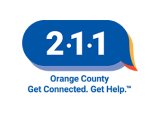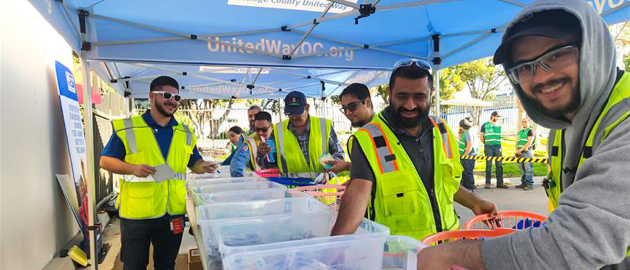Irvine, CA, June 27, 2018 — Orange County United Way is proud to partner with United Ways of California on the release of Struggling to Stay Afloat: The Real Cost Measure in California 2018, a new statewide report on financial challenges for working families.
Unlike the official federal poverty level, which does not accurately account for local costs of living, the Real Cost Measure looks at current costs of a basic needs budget for housing, food, health care, child care, transportation and other basic needs to determine what it truly costs to live in every county in California for households of different compositions (e.g., 2 adults, no children, or 2 adults, 1 infant and 1 school-age child). The results of this extensive study are presented in a data-rich website that enables users to examine each of California’s 58 counties at the neighborhood level, with county profiles and interactive maps.
“People don’t often associate poverty with Orange County, but the truth is that 30% of our local neighborhoods have a high concentration of financially unstable families,” said Susan B. Parks, president and CEO of Orange County United Way, referencing the FACE 2024 findings from this year. “The Real Cost Measure is bringing these alarming statistics to the forefront to remind us of the challenges affecting the future of our community. The good news is these challenges are reversible, but not without our help.”
Some of the key findings from The Real Cost Measure in Orange County include:
- More than one in three California households (33%) do not earn sufficient income to meet basic needs. In Orange County, 235,091 households live below the Real Cost Measure.
- Workers: In Orange County, a family of four (two adults, one infant, one school-age child) would need to hold more than 3 full-time, minimum-wage jobs to achieve economic security.
- Housing Burden: More than 4 in 10 households in Orange County (42%) pay more than 30% of their income on housing.
- Households of all Ethnicities Struggle, but Rate is Higher for Latino and African Americans: Across the state, African Americans and Latinos have a disproportionate number of households with incomes below the Self Sufficiency Standard. In Orange County, of the 235,091 households below the Real Cost Measure, 43% are Latino.
- Single Mothers: Nearly 7 in 10 single mothers in Orange County (67%) fall below the Real Cost Measure.
- As Education Increases, Rate of Struggling Households Falls: 70% of Orange County householders without a high school diploma or equivalent fall below the Real Cost Measure compared to those with at least a high school diploma (46%), at least some college education (30%), and at least a bachelor’s degree (15%).
- Foreign Born Households: 32% of households in Orange County led by a person born outside the U.S. are below the Real Cost Measure, and that number rises to 50% when the householder is not a citizen. Households led by Latino non-citizens struggle most, especially if the household does not include someone over 14 years of age who speaks English well.
- Seniors: Nearly 1 in 3 seniors in Orange County struggle to meet basic needs (26%) .
To help local families break the cycle of poverty, Orange County United Way has implemented programs and services to give individuals the tools they need to build financial stability. One example is SparkPoint OC, which provides hard working low-income residents with free financial resources and coaches for personal finance, savings and asset planning to escape financial hardship. Orange County United Way has also developed a workforce development program called UpSkill OC to bridge the skills gap and connect individuals to better paying careers. To help hardworking individuals keep more of their hard earned money, Orange County United Way additionally spearheads the OC Free Tax Prep program. This year, the OC Free Tax Prep program served 19,000 low-income taxpayers throughout Orange County bringing almost $16.3 million in federal and state refunds.
The Real Cost Measure online resources include interactive maps that reveal the number and percentage of households living below the Real Cost Measure, median household earnings and areas in which housing burden greater than 30 percent of a household’s gross income.
The study results also offer county profiles with detailed budgets that reflect minimum annual household needs at the county level. These household budgets, calculated for 2016, include the cost of housing, child care, food, health care, transportation, 10 percent miscellaneous expenses, tax credits and taxes. To learn more about the Real Cost Measure, please visit https://www.unitedwaysca.org/realcost.
ABOUT ORANGE COUNTY UNITED WAY
Today’s Orange County United Way fights for the Education, Health, Housing and Financial Stability of every person in Orange County. We focus on long-term solutions to the most critical interconnected challenges facing local children and families. Through our 10-year collaborative, community-wide action plan, “FACE 2024” (an acronym for Fund, Advocate, Collaborate, Educate), by 2024 we will cut the high school dropout rate in half, increase the number of healthy youth by one-third, cut the percentage of homeless and housing-insecure children in half and reduce the percentage of financially unstable families by 25%. By mobilizing local businesses, community organizations, governmental agencies and individuals, we make a long-term measurable difference in our community. UNITED4OC, we change the lives of adults and children right here in Orange County and create a brighter future for every one of us. To learn more or to join our fight, visit www.unitedwayoc.org.
# # #










